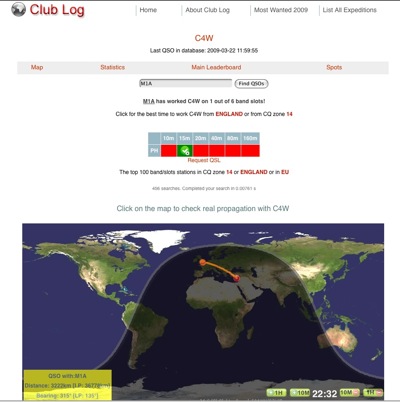|
|
| LGS file format |
- What is LGS?
- It's a highly optimised format that aims to reduce the log file size to a minimum to allow the efficient uploading of qso logs from remote locations. LGS is derived from LoGSearch.
- What software already supports LGS?
- For now Win-test and Club Log have support for the LGS format
- Who developed LGS?
- This was an idea by 5B4WN and was developed with the help of F6FVY (and F5MZN) after the TX5C expedition.
- What are the file specs?
- Simple ASCII, sample follows:
-
|
OPS:A-5B4WN,B-G0WWW,C-5B4AFM
STATIONS:A-STN5,B-STN7,C-STN6,D-EXTRA_1,E-STN3,F-STN1,G-STN4
BANDS:A-160,B-80,C-40,D-30,E-20,F-17,G-15,H-12,I-10,J-50
MODES:A-CW,B-SSB,C-RTTY,D-FM,E-PSK,F-PKT,G-HELL,H-SAT
UNIX_T:1205022521
A@21652@1,0GB,W5ZZ,B
B@21673@1,1EB,G3ZZ,C
A@21652@2,15GB,5B4ZZ,B
|
- All lines end with a \n character
- OPS: list the operators giving each one a letter. A-Z and a-z allows for 52 operators. Each letter is followed by a - then by the operators call then a comma. The last operator has no comma but a \n to mark the end of the field. ? is used for unknown data
- STATIONS: list the station ID. Win-test allows each computer to have a unique identifier which help obtain a unique identifier for each qso. Similarly to OPS: above STATIONS: is followed by a letter (A-Z or a-z) the followed by a - and then the station name followed by a , until the last station name which ends with a \n. ? is used for unknown data
- BANDS: (in meters) as above A-Z or a-z followed by - then band eg 160,80,40,30,20,17,15,12,10,6 then , or \n ? is used for unknown data
- MODES: as above: SSB,CW,RTTY,FM,PSK, PKT etc ? is used for unknown data
- UNIX_T: is the unix timestamp for the FIRST QSO in the list that follows (ends with a \n)
- The actual log then follows in the following format:
- A@21652@1,100GB,W5ZZ,B
- A@21652@1 [this is wintest unique ID for each qso eg A is index from STATIONS: list and 21652@1 is the unique QSO from that station. This becomes useful to identify if a qso has been modified in later uploads. A different uniqueId could be used instead.
- 100GB. 100 is the difference in seconds of this qso from the first qso in the list as given by UNIX_T: listed above. In this case its 100s after 1205022521 ie 1205022621. G is the band (15m) and B is the mode (SSB)
- Then is the callsign worked
- B is the Index of the operator callsign (G0WWW)
- Each of the above is separated by a ,
- The log is finally zipped before upload
- With this format a file of 70K QSOs is 2MB unzipped and 632Kb zipped.
|
|
| NEW logsearch utility now available via clublog |
A new FREE hosted service for DXpedition logsearch is now available at:
A new version of the logsearch applet is integrated into the ClubLog backend to provide a stable and reliable logsearch utility. I am grateful to Michael, G7VJR, creator of ClubLog for allowing me to integrate my logsearch applet with his fantastic software.
Here is a screenshot:

Note that the OLD logsearch utility is now OBSOLETE and no longer supported. |
|
| LogSearch Utility |
Although a number of log search utilities exist that are able to provide the important functionality of finding out whether you are "in the log" well, I wondered whether any improvements/interactivity would enrich the experience for dxers. I also wanted to create a way of facilitating log uploads to the log search server as well as optimising the transfer of logs using unreliable and expensive satellite phones.
I created the 5B4WN log search utility that has the followin features:
- Uses custom made log format that results in smaller log files that can be zipped and emailed to a unique logserver email address over satellite phone. This means that significant savings are made over unreliable links.
- The procedure of log upload is completely automatic ie once the log is emailed to the specific email address, the server opens the email, unzips, and uploads the qsos to the database
- DXers are able to search for their QSOs as soon as the above process is complete
- FAST! Log search results are returned in less than 1s
- The results are shown in a tabular format and apart from the mode/band worked, the DXpeditioning operator's callsign is also shown .
- Real propagation information is also available between the DX station and either the DXer's country or DXer's CQ zone. This propagation is derived by the analysis of ALL the QSOs in the database and is provided in a graphical format by means of bar charts by hour and by band. This can provide important information to the DXers who wish to contact the DXpedition on a specific band.
- To add a competitive nature to the DXpedition, a leaderboard is created based on how many band/mode slots DXers have worked the expedition. Note that the speed of working the expedition for ALL QSOs plays a role for the order displayed. In addition, DUPLICATE QSOs count negatively in the leaderboard ranking!
Expeditions that used the applet:
- 3B7C by FSDXA [the main reason I created this applet. I am grateful to them for their help, ideas and debugging]
- VP6DX
- TX5C
- YK9G
Future expeditions:
Will appear here once they are publicly announced!
I am also grateful to G3WGV for his help with developing the first efficient log format.
|
|
|

 DXpeditions
DXpeditions
